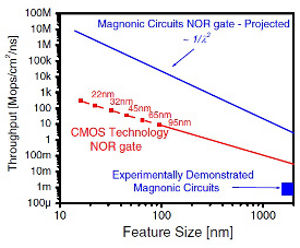Communications of the ACM
Researchers Analyze the Future of Transistor-Less Magnonic Logic Circuits
The emerging field of magnonics is attracting researchers because of its possible role in the development of transistorless logic circuits, and researchers are investigating how to use spin wave phenomena to make logic circuits.
Unlike CMOS logic circuits, which use electric current to store and transfer data, magnonic logic circuits use spin waves propagating in magnetic waveguides. By avoiding electric currents, magnonic logic circuits have the potential to enable more efficient data transfer and enhanced logic functionality, including parallel data processing.
 This figure compares CMOS logic and magnonic logicin terms of throughput as a function of the minimum feature size, which is the gate length for CMOS and the wavelength for a spin wave circuit. The throughput of demonstrated spin logic is prototypes is currently far below current CMOS technology. Credit: Alexander Khitun, et al / UCLA This figure compares CMOS logic and magnonic logicin terms of throughput as a function of the minimum feature size, which is the gate length for CMOS and the wavelength for a spin wave circuit. The throughput of demonstrated spin logic is prototypes is currently far below current CMOS technology. Credit: Alexander Khitun, et al / UCLA |
"The greatest potential advantage of magnonic logic circuits is the ability to process information in parallel on different frequencies, which is not possible for CMOS-based logic," says UCLA researcher Alexander Khitun.
From PhysOrg.com
View Full Article
Abstracts Copyright © 2010 Information Inc., Bethesda, Maryland, USA 
No entries found